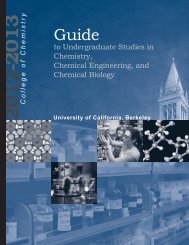Newsjournal body.qxp - College of Chemistry - University of ...
Newsjournal body.qxp - College of Chemistry - University of ...
Newsjournal body.qxp - College of Chemistry - University of ...
Create successful ePaper yourself
Turn your PDF publications into a flip-book with our unique Google optimized e-Paper software.
all courtesy Robert Bergman<br />
OUTREACH. Local elementary students get an eyeful—and a mouthful—when<br />
chemistry graduate students volunteer in the classroom. Organized by Amish<br />
Patel and Joseph Hooker (above right), the <strong>Chemistry</strong> in the Classroom program<br />
has helped more than 30 volunteers reach children through science.<br />
Much <strong>of</strong> her outreach activity takes place in April, when<br />
Jackson-Tribble helps newly admitted students who are in<br />
the process <strong>of</strong> deciding whether or not they should come to<br />
Cal and more specifically the <strong>College</strong> <strong>of</strong> <strong>Chemistry</strong>. She<br />
personally calls students and, with the rest <strong>of</strong> the undergraduate<br />
<strong>of</strong>fice, participates in Cal Day, the campus’s annual open<br />
house, where prospective students and the community can<br />
tour the campus and learn in depth about the various<br />
programs.<br />
For the past four summers, she has been the point-person<br />
for the college’s participation in “Experience Berkeley” (EB),<br />
an outreach project for underrepresented students funded<br />
by the Office <strong>of</strong> Admissions. Last summer 120 public high<br />
school students from the Los Angeles area visited the campus<br />
and learned more about on-campus life. “They lived in the<br />
dorms and attended writing classes and various workshops<br />
that included information on the UC application process,”<br />
noted Jackson-Tribble. EB participants also visited the<br />
<strong>College</strong> <strong>of</strong> <strong>Chemistry</strong> for lab tours and faculty lectures.<br />
Additionally, if time permits, she holds an event for<br />
National <strong>Chemistry</strong> Week in October. “Usually I invite<br />
elementary school groups to the college to do fun laboratory<br />
experiments, hear lively talks and see demonstrations.<br />
Graduate students in various research labs usually host this<br />
event,” she said. “One year we did a very special outreach<br />
project entitled ‘Girls Just Want to Have Fun with<br />
<strong>Chemistry</strong>’ for 80 high school women. Encouraging young<br />
women scholars to come to Cal is a very important part <strong>of</strong> our<br />
outreach component.”<br />
EXPERIENCE BERKELEY. Through a program sponsored by the Office <strong>of</strong><br />
Undergraduate Admissions, high school students get an up-close look at research<br />
and life in the <strong>College</strong>, meeting with current students and learning from pr<strong>of</strong>essors<br />
such as chemical engineering pr<strong>of</strong>essor Alex Bell.<br />
Expanding Your Horizons<br />
Expanding Your Horizons (EYH) also works with young<br />
women and encourages them to take math and<br />
science courses in high school, part <strong>of</strong> its effort to increase the<br />
number <strong>of</strong> women in science and engineering fields.<br />
Sponsored by the nonpr<strong>of</strong>it Math/Science Network, based at<br />
Mills <strong>College</strong> in Oakland, EYH <strong>of</strong>fers the opportunity for girls<br />
to discover the excitement <strong>of</strong> scientific discovery and the<br />
career opportunities in science and math-related fields like<br />
computer technology, engineering and medicine. <strong>College</strong><br />
members <strong>of</strong> Iota Sigma Pi, the national honor society for<br />
women in chemistry, consistently volunteer at the annual<br />
EYH event.<br />
On a chilly March morning, Allison Caster, a graduate<br />
student in chemistry, guided middle-school girls through<br />
numerous experiments in the “Colorful <strong>Chemistry</strong>” session<br />
<strong>of</strong> EYH. “The girls burned metal salts to get great colors and<br />
to learn about the electromagnetic spectrum,” Caster said. “It<br />
was a blast.” In the session, participants do hands-on<br />
reactions, making polymers and “super” bouncy balls,<br />
distinguishing chemical compounds by the colors that they<br />
give <strong>of</strong>f in a fire, flash freezing compounds and ending the<br />
session by “making liquid-nitrogen ice cream, which is<br />
always the most popular part <strong>of</strong> the program,” said Caster.<br />
The day includes a talk encouraging girls to persist in<br />
mathematics and science courses, and two varieties <strong>of</strong> workshops:<br />
participating in experiments and listening to role<br />
models discuss what their jobs involve on a daily basis. This<br />
was Deborah Michiko Aruguete’s second year to<br />
. . . . . . . . . . . . . . . . . . . . . . . . . . . . . . . . . . . . . . . . . . . . . . . . . . . . . . . .NEWSJOURNAL 2005<br />
15




